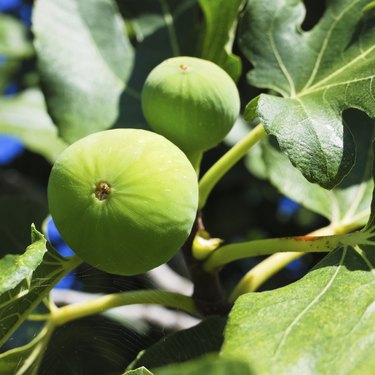
The common fig (Ficus carica) is a relatively tough native of the Mediterranean region which stands up well to heat and drought. It has no problem handling the North Carolina summer, but in the inland portions of the state, it requires some special care to do well through the winter.
Cold Hardiness and Cultivars
Video of the Day
The common fig is hardy in U.S. Department of Agriculture plant hardiness zones 6 to 10, so it can grow throughout North Carolina, where the climate ranges from USDA zone 6 in the mountains in the west to USDA zone 8 on the Coastal Plain.
Video of the Day
The fig is, however, sensitive to the cold and will likely need protection from winter weather in USDA zones 6 and 7 in the central and western parts of the state. In these areas, consider planting the trees near a south-facing wall and cover the tree's root zone with a thick layer of mulch; the mulch will protect the roots from cold in the winter and will also help with moisture retention in the summer. Ensure mulch doesn't touch the trunk.
The cultivars most commonly grown in the state are "Celeste" and "Brown Turkey."
Site Considerations
Fig trees grow best in a location where they get plenty of sun, and at least eight hours of sun per day, and consistent moisture. Sandy soils that may drain too quickly are prevalent on the Coastal Plain, while the Piedmont and other areas of the state are more likely to have heavier clay soils that don't drain quickly enough. If you're planting in sandy soil, mixing organic compost into the soil will improve its moisture-retention capabilities, and adding the same compost to clay soil can improve drainage.
Figs grow best in slightly acidic soil with a pH level between 6 and 6.5. If a soil test indicates that your soil is more acidic than this, which is often true of North Carolina soils, you can raise its pH level by tilling lime into the top few inches of soil. The amount of lime you'll need to add depends on the consistency of your soil; adding about a half ton of lime to an acre of sandy soil will raise the soil's pH by about a point, but heavier soils will require more. The pH level will go up very slowly after application, so add lime several months before planting.
Ensure fig trees are spaced at least 15 to 20 feet apart.
Fertilization and Watering
Overfeeding figs with nitrogen will encourage foliage growth at the expense of fruit, and fertilizing in the summer will cause late-season growth that is more vulnerable to damage in the winter. If you're growing trees in sandy soils, apply an 8-8-8 fertilizer to the soil around the base of the tree annually, using a pound for each year of the tree's age up to 12 years. Apply half the fertilizer as the buds begin to swell and the other half in May. In clay soils, fertilizer is likely not necessary.
Once established, fig trees are tolerant of drought conditions and don't need much watering except during dry periods that last more than a few weeks. In the first year after planting, however, water young trees three times week, giving them 10 gallons of water each time.
Nematode Problems
Fig trees are vulnerable to attack by root knot nematodes, tiny worms that feed on the trees' root systems. The pests feed on the roots of fig trees, causing knotty galls to form on the roots. Other symptoms of an infestation include poor growth or fruit production and yellowed foliage.
Nematodes are especially problematic in sandy soils, and they also may be present in locations where tomatoes, okra or tobacco have previously been grown. No chemical treatment has yet proven effective in ridding infested soil of nematodes.The best management course for nematode problems is to amend the soil with organic compost at planting time and to provide regular irrigation so that the tree remains healthy and better able to fight off the effects of the infestation.